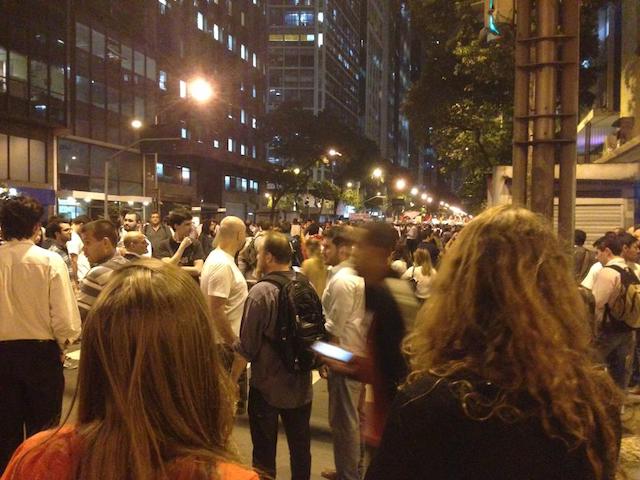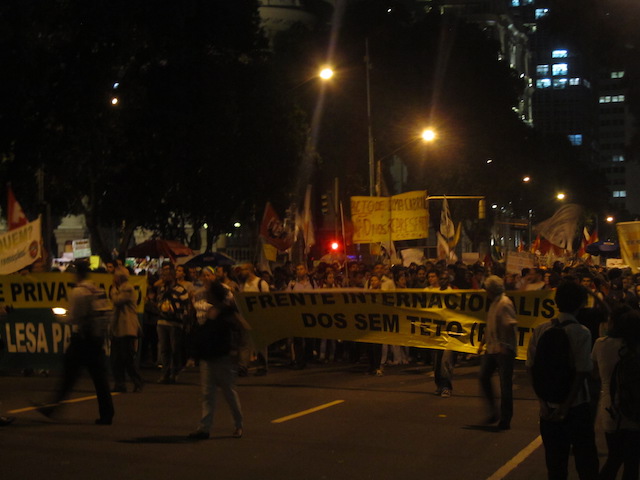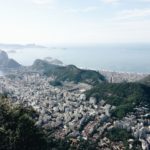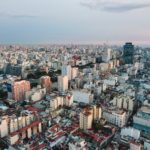Reflections on the Recent Brazil Protests


In the early weeks, what started out as non-violent protests often ended with tear gas, pepper spray and rubber bullets. The mainstream media reported that protestors provoked the policia militar by damaging property, starting fires and throwing rocks, authorizing the police to respond. What went unreported by major media outlets was the failure to use proportionate responses.
Most participants and observers agreed that the police did not have enough training and some have questioned whether there was an intentional use of force to discourage the protestors.
I heard reports about the tear gas spreading to the nearby bars and concert venues of neighboring Lapa, a bairro known for its Samba music.

I heard reports about the tear gas spreading to the nearby bars and concert venues of neighboring Lapa, a bairro known for its Samba music. Even more worrisome, the city government of Rio de Janeiro chose to repeatedly close the downtown metro stations closest to the protests. Rather than discouraging people from attending the protests, it made it much more difficult for protestors and observers alike to leave the area placing everyone at some risk should things get out of hand. My own experience of being caught between several police officials standing in position with their hands on their holstered weapons to my left and the masses marching in the street to my right reinforced the volatility and uncertainty of the environment.
While protests began in São Paulo to contest the increase in bus fare from R$2.75 to R$2.95 (equivalent to a $0.09 difference in US dollars), the movement spread around the nation after a violent police response at one of the early demonstrations. The manifestações reached a national scale on June 17th when more than one million Brazilians marched in the streets making it arguably the largest public demonstrations since the 1985 return to democracy. In addition to expanding geographically, the movement also grew in its breadth of issues as Brazilians expressed further frustrations with the current state of national affairs.
When the protests first started, a writer for the Economist magazine nicknamed the demonstration the “salad revolution” because towels soaked with vinegar were used to counter the effects of tear gas. As the manifestações have continued, several key themes have emerged: demands for improved public transportation; objections to infrastructure spending for the World Cup and Olympics; lack of investment in healthcare and education; and widespread political corruption.
It is no coincidence that the largest protests are occurring in Rio de Janeiro, the city that will host four mega events leading up to the 2016 Olympics. In 2009, analysts estimated that World Cup and the Olympics would each cost approximately $14.5 billion.
Bus fares are just one example of the high cost of living in Brazil and overall economic growth has slowed from a 2010 peak of 7.5% to an estimated low of 0.9% in 2012. Additionally, inflation has hovered at about 6.5% over the past twelve months. This figure has reached the top of the government’s target range—and has caused concerns on what is historically a very sensitive issue. The Brazilian middle class has been most affected by the economic climate and has felt a decline in the quality of life—with speculation increasing rent prices and limiting discretionary spending. While the macro-economic conditions may not be the overriding force compelling the protestors to take the streets, they are undoubtedly, an underlying factor.
It is no coincidence that the largest protests are occurring in Rio de Janeiro, the city that will host four mega events leading up to the 2016 Olympics. In 2009, analysts estimated that World Cup and the Olympics would each cost approximately $14.5 billion. The price tag on both events has increased and is likely to continue to escalate until the respective opening ceremonies.
Reflections on the Recent Brazil Protests.
Additional costs include the rising real estate prices due to speculation as well as the opportunity cost of foregoing investment in other arenas. There are also uncertainties as to whether broad private investment will actually benefit the city and a wider population of Brazilians than those who are in the construction industry or plan to attend the various events. In fact, a popular phrase heard around Rio in offices, beaches and restaurants is “imagina na copa”, consider what things will be like during the World Cup!

The other major concern highlighted by the protestors is the perceived widespread political corruption. Despite Brazilian President Dilma Rousseff efforts to make fighting corruption a mainstay of her political agenda, it remains a contentious at the local, state and federal levels. Just prior to the protests, the Brazilian Congress discussed two bills that would simultaneously strengthen legislative power, but diminish individual elected representative accountability. The first law proposed to allow Congress to review Supreme Court decisions; while the second piece of legislation prevented members of Congress from being tried in regular courts.
At the first demonstration I attended, I observed the black and white masks donned by some of the protestors and wondered about their significance. As I later learned, these masks became the hallmark image for one of the groups decrying political corruption. Under pressure to respond to the manifestações, the Brazilian Congress passed legislation that makes political corruption a crime hediondo, or a felony; the enforcement of this new law will be something to monitor closely in the coming months.
What kind of change can this momentum generate? Is a mass mobilization of the general populace sufficient to bring about systemic change after the demonstrations end?
In response to the demonstrations, President Rousseff commended the peaceful protestors whose actions were recognized as symbolic of the strength of Brazil’s democracy. In a June 21st pre-recorded speech, the President announced that the government would recruit additional physicians from around the world to improve healthcare and redirect oil profits into education. However, after drawing a lackluster response from the general public over these concessions, Rousseff assembled a group of regional governors and city mayors to produce a more detailed five-point proposal. While many Brazilians view these federal and state concessions as progress, some are still not yet satisfied and these actions may not be enough to appease the movement.
Almost a month after the first São Paulo protest, the demonstrations continue in different neighborhoods and cities, though the size and scale of the marches have been smaller. Regardless of the smaller scope of the ongoing protests, the combination of spontaneity and decentralization of the movement make it unlikely that the protests will come to a quick end.
Speculating on the future, Paulo Sotero, Director of the Woodrow Wilson Brazil Institute, commented recently that he expects the movement to continue for some time because of the communication gap that exists between Brazilian youth and the national political parties. Without a meaningful channel for representation through the current system, he concludes that people have taken to the streets to broadcast their message.
Reflections on the Recent Brazil Protests.
What kind of change can this momentum generate? Is a mass mobilization of the general populace sufficient to bring about systemic change after the demonstrations end? How can Brazil capitalize on this outpouring of public support to modify its domestic policy? Going forward, we will have to wait and see what the coming weeks and months bring. As the protestors chant, “seu filho não fuga da luta”, they hint at the lyrics of the Brazilian National Anthem, which promises the nation will not back down from a fight.
Photos by Melanie Kaplan.








